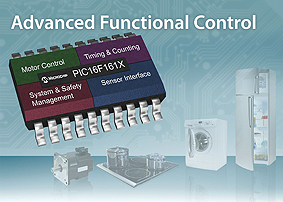Microchip announces, from Electronica in Germany, an expansion of its 8-bit PIC® microcontroller (MCU) portfolio, with the

peripheral-rich, low-pin count PIC16(L) F161X family. These new MCUs introduce and expand the offering of Microchip’s Core Independent Peripherals (CIP), which were designed to reduce interrupt latency, lower power consumption and increase system efficiency and safety, while minimising design time and effort. These peripherals also reduce system complexity by eliminating the need for additional code and external components. Hardware-based peripherals offload timing-critical and core-intensive functions from the CPU, allowing it to focus on other critical tasks within the system.
The PIC16(L)F161X PIC MCUs offer the Math Accelerator (Math ACC) with Proportional Integral Derivative (PID), which provide completely Core Independent calculations, with the capability to perform 16-bit math and PID operations. The family also includes the Angular Timer (AngTmr), which is a hardware module that calculates the rotational angle in functions, such as motor control, TRIAC control, or Capacitive Discharge Ignition (CDI) systems. Regardless of speed, the AngTmr allows recurring interrupts at a specific rotational or sinusoidal angle without using the core’s computation. The CIPs can be configured to perform a host of given functions that increase execution speeds and decrease software requirements. Offloading these functions frees up the CPU do other tasks, consumes less programme memory, and reduces the overall power consumption of the MCU.
In addition to the MATH ACC and AngTmr, the PIC16(L)F161X features several other peripherals designed to ease implementation and add flexibility of various functions. The 24-bit Signal Measurement Timer (SMT) performs high-resolution measurements of the digital signal, in hardware, resulting in more precise and accurate measurements. This is ideal for speed control, range finding and RPM indicators. The family also includes a Zero Cross Detect (ZCD) module, which can monitor AC line voltage, and indicate zero crossing activity, simplifying TRIAC control applications by greatly reducing both CPU demand and BOM cost. In combination with the new 100 mA, high-current I/Os, the proven Configurable Logic Cell (CLC), and I2C™, SPI and EUSART for communications, this high level of integration helps to speed design, eases implementation and adds flexibility.
Microchip Technology
www.microchip.com/PIC16_LF161X-Family-Product-Page-111114a


